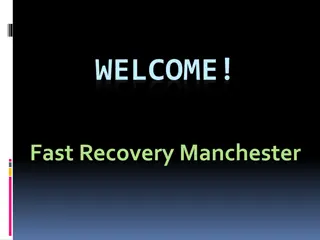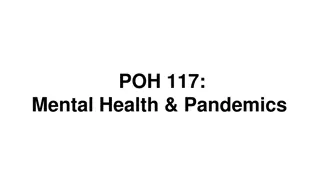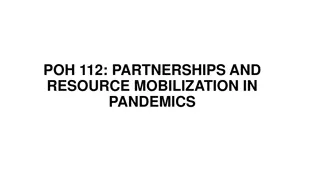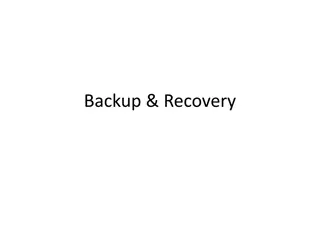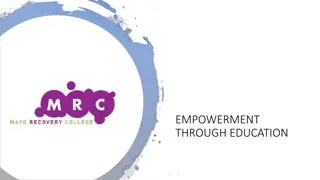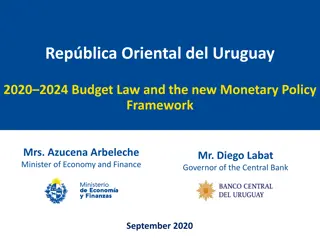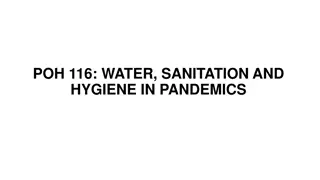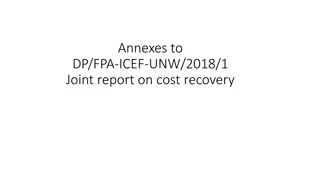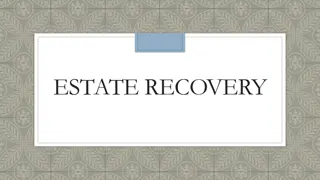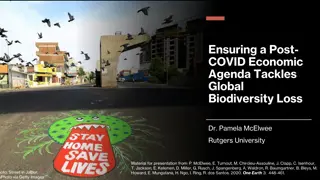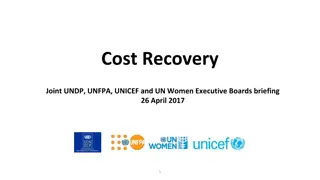Understanding Economic Recovery in Pandemics
This chapter delves into the economic recovery phase during pandemics, focusing on key aspects such as the recovery interval, historical perspective, components of economic recovery, pre-existing conditions, roadblocks, strategies to combat the disease, and potential shapes of economic recovery. It emphasizes the importance of planning for recovery during shutdowns and recessions, highlighting the unpredictability of epidemiological conditions and the need for flexible decision-making in policy implementation.
Download Presentation

Please find below an Image/Link to download the presentation.
The content on the website is provided AS IS for your information and personal use only. It may not be sold, licensed, or shared on other websites without obtaining consent from the author. Download presentation by click this link. If you encounter any issues during the download, it is possible that the publisher has removed the file from their server.
E N D
Presentation Transcript
Economics of Recovery Economics of Recovery PANDEMIC ECONOMICS PANDEMIC ECONOMICS CHAPTER 6 CHAPTER 6 1 PANDEMIC ECONOMICS, CHAPTER 6
Topics Topics 1. Recovery Interval 2. Economic Recovery in Historical Perspective 3. Components of Economic Recovery 4. The Importance of Strong Pre-existing Conditions 5. Roadblocks to Economic Recovery 6. Strategies to Fight the Disease 7. The Shape of Economic Recovery 2 PANDEMIC ECONOMICS, CHAPTER 6
Learning Objectives Learning Objectives After reading this chapter, you will be able to: After reading this chapter, you will be able to: LO1 Describe the recovery interval of the pandemic phase. LO2 Establish historical perspective for economic recoveries. LO3 Explain the components of economic recovery. LO4 Address the importance strong pre-existing conditions. LO5 Discuss roadblocks to economic recovery. LO6 Contrast different strategies to fight the disease. LO7 Consider potential shapes of economic recovery. 3 PANDEMIC ECONOMICS 10
1. Recovery Interval 1. Recovery Interval This chapter analyzes the third economic interval of the pandemic phase: recovery Shutdown Recession Recovery 4 PANDEMIC ECONOMICS, CHAPTER 6
Process of Economic Recovery Process of Economic Recovery During the pandemic phase after economic shutdown and during recession planning begins for economic recovery. When the disease is under control, businesses re-open. People re-emerge from their homes. Public sectors reduce restrictions on economic activity. 5 PANDEMIC ECONOMICS, CHAPTER 6
Policy Realities Policy Realities Unpredictable epidemiological conditions lead to challenging policy realities. While a blueprint for an optimal recovery includes testing, contact tracing, targeted isolation, a reasonable timeline, appropriate jurisdiction, and economic mobilization, the process requires flexible decision making. 6 PANDEMIC ECONOMICS, CHAPTER 6
7 PANDEMIC ECONOMICS, CHAPTER 6
With respect to lethality and global reach, the 1918 influenza pandemic establishes historical perspective for the 2020 coronavirus pandemic. For both mortality and economic outcomes, the influenza pandemic provides a reasonable upper bound. 2. Economic 2. Economic Recovery in Recovery in Historical Historical Perspective Perspective Many countries reacted to the influenza pandemic, which began and peaked in 1918 but lasted until 1920, with lockdowns and other non-pharmaceutical interventions. The influenza pandemic killed around 50 million people, approximately 2.1 percent of the global population, representing a likely peak in mortality from a natural disaster in modern times. 8 PANDEMIC ECONOMICS, CHAPTER 6
After shutdown and recession, data- driven epidemiological and economic instructions guide economic recovery. The recovery begins after the disease is contained. The process includes a roadmap to pandemic resilience. 3. 3. Components Components of Economic of Economic Recovery Recovery 9 PANDEMIC ECONOMICS, CHAPTER 6
Roadmap to Pandemic Resilience Roadmap to Pandemic Resilience A Harvard University study, Roadmap to Pandemic Resilience (2020), establishes the strategy, arguing that, before economic recovery, public sectors must establish three components: A system of testing, tracing, and supported isolation Appropriate policy jurisdiction A plan for economic mobilization 10 PANDEMIC ECONOMICS, CHAPTER 6
Testing, Tracing, and Supported Isolation (TTSI) Testing, Tracing, and Supported Isolation (TTSI) The system for TTSI recommends the establishment of testing oversight for the disease at the national level, guidance at the state level, and innovation in testing methods at the local level. With contact tracing, health officials identify individuals who may have encountered infected people. For individuals with infections that must isolate, support provides a method of reducing anxiety and vulnerability. 11 PANDEMIC ECONOMICS, CHAPTER 6
Policy Jurisdiction Policy Jurisdiction The national government should provide surge capacity for the healthcare system and monitor the spread of the disease. States should activate surge capacity, establish municipal safety guidelines, and supply testing resources. Local governments should design and administer testing programs, support people emerging from isolation, and report epidemiological data. 12 PANDEMIC ECONOMICS, CHAPTER 6
Plan for Economic Mobilization Plan for Economic Mobilization After implementing a strong disease containment strategy, policymakers should establish a staggered process of economic mobilization, which includes consideration of: Disease networks Transmission hubs New forms of business activity Phases A targeted business approach 13 PANDEMIC ECONOMICS, CHAPTER 6
Market Considerations Market Considerations With a phased-in approach, some businesses re-open before others. Three reasons exist. First, not all business activity is essential. Second, business activity differs with respect to crowding. Third, the existence of latent periods for the disease leads to exploitation of the disease s weak spot. 14 PANDEMIC ECONOMICS, CHAPTER 6
CROWDING APPROACH LATENT PERIOD APPROACH The crowding approach to re-opening businesses sorts them by the average visit length and average number of weekly visits per square foot. The idea of a latent-period approach is that people work in two-week cycles: on the job for four days and then 10 days of quarantine, to safeguard against the spread of the disease. 15 PANDEMIC ECONOMICS, CHAPTER 6
16 PANDEMIC ECONOMICS, CHAPTER 6
An effective economic recovery requires a strategic response, but it benefits from strong pre-existing economic conditions, such as: efficient government low deficits innovation capacity to create new business models technological advance flexible labor market 4. The 4. The Importance of Importance of Strong Pre Strong Pre- - Existing Existing Conditions Conditions 17 PANDEMIC ECONOMICS, CHAPTER 6
Government Responses Government Responses Effective Responses Transparent governance, collaborative structures Efficient and effective dissemination Modern information technology Ineffective Responses Top-down governance, structures Lack of information dissemination bureaucratic information Poor technology Information dissemination to specific populations Strong community vigilance Misinformation Weak community vigilance Collaboration Lack of collaboration Evidence-based decision-making Lack of data consideration 18 PANDEMIC ECONOMICS, CHAPTER 6
During economic recovery, roadblocks emerge, because no single intervention is completely effective in stopping the spread of disease. Each intervention has holes or weaknesses. To fight a pandemic, both personal responsibility and shared responsibilities are necessary. 5. Roadblocks 5. Roadblocks to Economic to Economic Recovery Recovery 19 PANDEMIC ECONOMICS, CHAPTER 6
Specific Roadblocks to Economic Recovery Specific Roadblocks to Economic Recovery Roadblock Economic haste Hesitation Lack of childcare Political pressure from above Protracted advances Quarantine fatigue Social pressure below Uncoordinated strategy Explanation Entails the prioritization of the economy over health Results from doubts about the safety of the marketplace Inhibits the ability of parents to return to work Prevents a coordinated process of recovery medical Slows the development of a vaccine Complicates the process of recovery Pressures leaders to deviate from recovery guidelines from Complicates the process of an effective and coordinated response 20 PANDEMIC ECONOMICS, CHAPTER 6
The Boston Consulting Group identifies three strategies to fight the disease: crush and contain flatten and fight sustain and support Each strategy differs with respect to objectives and outcomes. Each strategy includes different methods of combining the economic and epidemiological components of recovery. 6. Strategies 6. Strategies to Fight the to Fight the Disease Disease 21 PANDEMIC ECONOMICS, CHAPTER 6
Crush and Contain Full containment to reduce the number of new cases close to zero with stringent lockdowns and aggressive testing, tracking, contract tracing, quarantining, and isolating Opening the economy in a walled society, focusing on strict border controls, and restoring economic vitality Flatten and Fight Attempted containment with interventions to decrease the number of cases and avoid overwhelming the healthcare system s capacity Progressively lifting the restrictions and reopening the economy without surpassing the healthcare system s limits -Resources to expand the healthcare system s capacity -Ability to increase testing and contact tracing -Adherence to safety protocols during reopening Austria, Australia, Denmark, Germany, Italy, Norway, and U.K. Sustain and Support Open containment with moderate interventions and primary reliance on voluntary restraint to limit the number of cases until herd immunity, vaccine, or cure Objectives Prolonged quarantining of the vulnerable population, while the less vulnerable pursue economic activities Implications for restarting the economy -Early, stringent interventions -Acceptance of prolonged lockdowns -Strict border controls -Ability to isolate and support the vulnerable -High trust in government translating into high compliance levels -Favorable demographics Prerequisites China, New Zealand, South Korea, and Taiwan Sweden Country examples 22 PANDEMIC ECONOMICS, CHAPTER 6
Crush and Contain Crush and Contain During the coronavirus pandemic, the most successful strategy was crush and contain, decisively crushing the disease when it appeared and aggressively containing it during additional outbreaks. This strategy prioritizes health before wealth, because containing the disease leads to a shorter period of economic shutdown. 23 PANDEMIC ECONOMICS, CHAPTER 6
24 PANDEMIC ECONOMICS, CHAPTER 6
25 PANDEMIC ECONOMICS, CHAPTER 6
Flatten and Fight Flatten and Fight During the coronavirus pandemic, many countries struggled to stop the spread of the disease. The inability to prevent disease hotspots led to a lack of containment during the first infection wave. 26 PANDEMIC ECONOMICS, CHAPTER 6
27 PANDEMIC ECONOMICS, CHAPTER 6
28 PANDEMIC ECONOMICS, CHAPTER 6
Sustain and Support Sustain and Support This approach avoids disease containment but includes moderate economic shutdown interventions. It involves selective and largely voluntary restrictions, protecting vulnerable members of the population while keeping much of the economy open. The goal is not to flatten the epidemic curve but to achieve herd immunity among the healthy and young. 29 PANDEMIC ECONOMICS, CHAPTER 6
30 PANDEMIC ECONOMICS, CHAPTER 6
Countries May Struggle to Contain the Disease Countries May Struggle to Contain the Disease Even with the implementation of shutdown interventions, some countries experienced uncontrolled transmissions during 2020, characterized by the continued growth of confirmed cases. Two examples: United States Brazil 31 PANDEMIC ECONOMICS, CHAPTER 6
Deaths During the Second Infection Wave in 2020 Deaths During the Second Infection Wave in 2020 Compared to the First Infection Wave Compared to the First Infection Wave Country First wave deaths per 100,000 people 0.10 Second wave deaths per 100,000 people 1.97 Second wave as % of first wave Czech Republic 2,011% Greece 0.05 0.93 1,950% Hungary 0.14 1.42 1,031% Austria 0.24 1.21 495% Iceland 0.16 0.44 275% Portugal 0.31 0.75 241% Germany 0.33 0.41 123% 32 PANDEMIC ECONOMICS, CHAPTER 6
7. The Shape of Economic Recovery 7. The Shape of Economic Recovery Economic and epidemiological factors determine the shape of economic recovery, including infection waves, changes in economic activity, and the appearance of a vaccine. Whatever the case, the shape of economic recovery is only clear in hindsight, and may assume different shapes, including V, U, W, L, and reverse radicals. 33 PANDEMIC ECONOMICS, CHAPTER 6
34 PANDEMIC ECONOMICS, CHAPTER 6
Summary Summary After shutdown and recession, recovery serves as the third economic interval of the pandemic phase. Meeting the challenge of a global, complex, and multi-dimensional pandemic requires a comprehensive data ecosystem that links the economy with public health. The recovery interval begins when the spread of disease is under control and it is safe to re-open businesses and send employees back to work. 35 PANDEMIC ECONOMICS, CHAPTER 6


